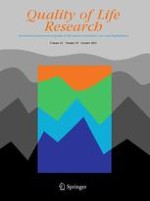05-04-2015
Factors associated with the quality of life of Korean COPD patients as measured by the EQ-5D
Gepubliceerd in: Quality of Life Research | Uitgave 10/2015
Log in om toegang te krijgenAbstract
Purpose
This study evaluated the health-related quality of life measured using the EuroQol five-dimension questionnaire (EQ-5D) and the degree of airway obstruction in a Korean population using Korea National Health and Nutritional Examination Survey (KNHANES IV–V, 2007–2010) data.
Methods
A cross-sectional analysis examined 2356 subjects (1178 COPD patients, 1178 control subjects) aged ≥40 years and performed reliable spirometry as part of KNHANES IV–V. Baseline EQ-5D visual analog scale (VAS) and EQ-5D utility scores were obtained. A Tobit censored regression model was used to evaluate factors affecting EQ-5D in COPD patients.
Results
The EQ-5D VAS and EQ-5D utility scores were significantly different among the COPD severity groups (P < 0.05). The mean EQ-5D VAS scores for patients with mild, moderate, and severe COPD were 73.0 (SD 18.6), 70.8 (19.1), and 60.9 (23.4), respectively. The mean utility scores were 0.90 (0.14) for patients with mild COPD, 0.89 (0.14) for patients with moderate COPD, and 0.84 (0.15) for patients with severe COPD. Factors influencing the EQ-5D utility score in patients with COPD were age, gender, household income, education level, severe airflow obstruction, and comorbidities.
Conclusions
The EQ-5D score could be a useful instrument for evaluating the quality of life of COPD patients in Korea. In Korean COPD patients, the main determinants of EQ-5D scores include older age, female gender, lower household income, lower education level, severe airflow obstruction, and many comorbid diseases.
